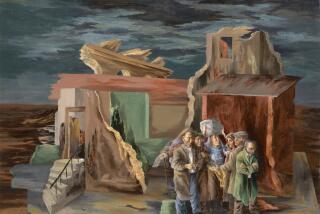A suggestion to replace art with reproductions in bankrupt Detroit
Did you know that Michiganders, in general, and Detroiters, in particular, are idle, good-for-nothing spendthrifts?
Michael Kinsley thinks so. The New Republicâs editor-at-large has written a snarky new column contemplating possible masterpiece sales from the Detroit Institute of Arts in the face of civic bankruptcy. The commentator likens the Motor City to the stately homes of England, which went into a âDownton Abbeyâ tailspin a century ago as Britain and the East India Co. began their inevitable rot.
âThere is a rich tradition of wastrels squandering the family fortune, then taking a few canvases to the pawnbrokerâs.â
CRITICSâ PICKS: What to watch, where to go, what to eat
There is also a rich tradition of know-nothings writing about art and museums.
To that end Kinsley dredges up the late right-wing political scientist (and art know-nothing) Edward C. Banfield. He was a pal of political philosopher Leo Strauss and economist Milton Friedman, who did so much to implement the social prescriptions that drove the country into a ditch in 2008, dooming Detroit in the process. A quarter-century before that, as Ronald and Nancy Reagan were anticipating a fancy second inaugural, Banfield proposed that the art museums of America be emptied, their collections sold and replaced.
Replaced by what? Why, by high-definition reproductions of paintings and sculptures made possible by the wonders of advanced technologies.
ART: Can you guess the high price?
Art for the aristocrats, reproductions for the peasants. As public policy the plan possesses a certain simplicity, as well as more than a little contempt for any governmental role in promoting the general welfare.
Even the late neoconservative art critic Hilton Kramer, who dallied on the same tattered end of the political spectrum as Banfield, made fun of the daft proposal contained in Banfieldâs now all-but-forgotten 1984 book, âThe Democratic Muse: Visual Arts and the Public Interest.â Kramer dubbed it âa ghastly intellectual fraud.â
Kinsley sighs that âArt snobs would be horrifiedâ by taking up Banfieldâs quest. Well, Kramer was certainly a snob, though I imagine that people who merely like art but arenât disdainful of others with different interests might also object.
CHEAT SHEET: Fall arts preview
Concluding his column with a lame demurral that borders on âKidding! Just kidding!,â he suggests that, if the sales deed is to be done, Detroit should wait until the cover of darkness before hauling masterpieces off to the auction block and installing fakes in their stead. Why? Because presumably no one would catch on.
Between an actual painting and a poster of it, Kinsley concurs with Banfield that âmost museum visitors couldnât tell the difference (I certainly couldnât).â This slide into phony populism is one that even Violet, dowager countess of Grantham, might regard with raised eyebrow and a double-take.
Kinsleyâs column, âA Modest Proposal,â flops as Swiftian satire because it operates under the common misconception that art is for everyone, even though it isnât. Art is not for everyone (that would be TV), itâs for anyone -- which is not the same thing.
When it comes to art museums, neither Kinsley nor Banfield seems to understand that a great thing about democracy is that it aspires to create opportunities for anyone to become an elitist, without old aristocratic demands like correct bloodline, appropriate religion or sufficient wealth. Thatâs a primary reason we even have places like the Detroit Institute of Arts, filled with great paintings and sculptures and open to all.
More to Read
The biggest entertainment stories
Get our big stories about Hollywood, film, television, music, arts, culture and more right in your inbox as soon as they publish.
You may occasionally receive promotional content from the Los Angeles Times.











